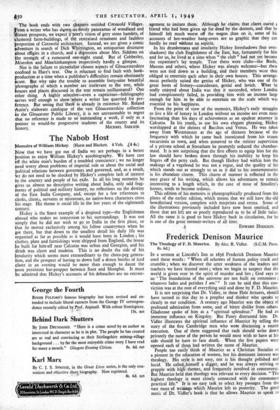Gloucestershire Rambles
Gloucestershire. By Kenneth Hare. (Robert Hale. 15s.) You will not (if, as I presume, you read in 1946 his buoyant, bustling, wayward and reluctantly discreet autobiography No Quarrel With Fate) expect from Mr. Kenneth Hare a smoothly proportioned description of the county of Gloucester. You will rightly anticipate digressive indignation and enthusiasms, tilts at windmills, been released from bonnets, and (almost literally) a King Charles's head. Here is a poet, more than a little of scholar, and a man unabashedly curious about life and other people. But he is not a measured writer, not a writer who keeps the pattern of his work steadily in view, or restrains himself from airing his personal prejudices which are many and rampageous, but never peevish or self-pitying. You must, therefore, accept Hare for what he is—an exhilarating and often incalculable guide, in whose wake we can only scamper, echoing the cry of the eighteenth-century hare-hunters which gave Soho its modern name.
Seven of the seventeen chapters of Hare's Gloucestershire are historical. Is this not too many ? The editor of the County Books declares that his series shall " not be a mere recital• of facts- already available." But not even Hare's robust and genial story-telling can alter the fact that Stone Age, Roman, Mediaeval and Civil-War Gloucestershire have already been amply studied. But then Hare thoroughly enjoys describing the race for the Severn between Yorkists and Lancastrians, and Massey's obstinate defence of Gloucester for the Parliament which, in effect, sealed the fate of
Charles I. •
We then proceed to local encounters (for which Hare has a genius), to local legends, to local proverbs and traditional sports, to local drinks and to local food. These five chapters are the best in the book, because they leave the writer free to wander--talkative and endlessly inquisitive—from pub to Farmers' Ordinary, from gaffers' gossip to the fun of old wives' tales. They contain precisely the traditional facts, the anecdotal information, the lore handed down from father to son, which give depth, background and englishry to any old-established countryside ; and they are written with an unaffected and highly personal gusto exactly suited to their themes. Baffled by conflicting stories about a haunted house, Hare spends an hour in a Stroud tavern writing a ballad called " The Gates," which is as good as a good Ingoldsby Legend and deserves (however fictional) to find a permanent place in Gloucestershire folk-lore. At the cheese-rolling near Birdlip we become eye- witnesses of a local sport dating back to the Middle Ages • though, alas, the hurtling Double Gloucester, with the lads of the village in breakneck pursuit, is now Summerskill-Ersatz and made of rubber. The chapter on the wines for which the country was once famous, on the genuine cider and perry now diluted ghosts of their old selves, on Gloucestershire punch and dandelion wine gives Hare a grand opportunity to trounce puritans, spoiksports and tax- gatherers. But in his three final sections his incorrigible ebullience returns in full force. Surely, if eleven pages about " great Gloucestrians " are given to W. H. Davies and James Elroy Flecker, brief mention at least should be made of William Ernest Henley, whose robust and forthright prejudices were precursors of Hare's own ? And is it not rather hard on G. B. S. to be denigrated as a " colossus of publicity" vis-à-vis Davies's self-withdrawing modesty, seeing that Shaw forced Davies on the public consciousness by a preface to the Autobiography of a Supertramp? The book ends with two chapters entitled Cotswold Villages. from a writer who has shpwn usiovely panoramas of woodland and distant prospects, we 'expect a poet's vision of grey stone hamlets, of clustered farm-buildings, of tht restrained ornament and faultless Proportion of Cotswold architecture. Instead, we are given a comic Ildventure in search of Dick Whittington, an antiquarian discourse about effigies in a church, and a digression about Mrs. Siddons on the strength of a rumoured one-night stand. But of Cobberley, Miserden and Minchinhampton respectively hardly a glimpse.
Nor is the failure to pictorialise chosen aspects of Gloucestershire confined to Hare's text. One is reluctant to find fault with book- production at a time when a publisher's difficulties remain obstinately Ocute. But why take the trouble to assemble forty-nine beautiful Photographs of which a number are irrelevant to the text, while houses and places discussed in the text remain unillustrated? One other thing. A highly selective—even a capricious—bibliography serves well enough to show where a writer has quarried for pre- ference. But seeing that there- is already in existence Mr. Roland Autin's elaborate catalogue of the vast Gloucestershire collection in the Gloucester Public Library, it is not unreasonable to regret that no reference is made to so outstanding a work, if only as a pointer to would-be progressive students of the county and its







































 Previous page
Previous page